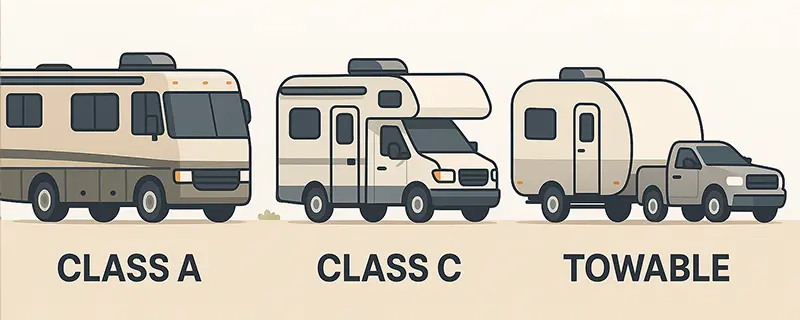The quick overview
Buying your first RV is exciting—but the options can be overwhelming. Start by matching your travel style, budget, and driving comfort to the right rig type. Use the comparison below, then follow the decision tree and checklist.
Pick your path: simple decision tree
- Hate towing? Prefer “park and live” convenience → Motorhome (A for space; C for easier driving).
- Already own a capable tow vehicle? Want budget flexibility → Towable (5th wheel for stability/space; travel trailer for lighter weight).
- Plan extended stays (30+ days)? Value storage and home-like layouts → Class A or 5th wheel.
- Short trips, national parks, tighter sites? Prioritize maneuverability → Class C or smaller travel trailer.
- Sleeping 5–7 regularly? Class C with cab-over + bunk model, or bunkhouse trailer.
Budgeting beyond the sticker price
- Insurance & registration: Varies by rig/region—get quotes before committing.
- Maintenance & wear items: Tires, batteries, roof seals, brakes (motorhomes add engine/chassis service).
- Fuel: Larger motorhomes consume more; towables depend on your tow vehicle.
- Upgrades: Brake controller, weight-distribution/sway control (towables), leveling, solar, Wi-Fi gear.
- Campsites & storage: Oversize rigs may limit campground options or increase nightly rates.
Must-know weight & safety basics
- GVWR / GCWR: Don’t exceed the rig’s or combo’s rated limits.
- Tow ratings: Match trailer fully loaded weight to your vehicle’s towing capacity; mind payload (passengers, cargo, tongue).
- Tongue/Pin weight: Aim ~10–15% of trailer weight on the hitch (5th wheels often higher).
- Braking & control: Quality brake controller (trailers with electric brakes) and weight-distribution/sway (travel trailers).
- Mirrors & cameras: Ensure clear rear/side visibility.
Test-drive & inspection checklist (bring this on your shopping day)
For motorhomes (Class A/C):
- Start cold; listen for rough idle; check service records.
- Drive at highway speed and on a grade; assess braking, sway, and noise.
- Test generator, inverter/charger, slides, leveling jacks.
- Walk roof (if safe): inspect seals, soft spots, previous repairs.
- Verify tire date codes (DOT), battery age, and all appliances.
For towables (travel trailer/5th wheel):
- Verify frame integrity, signs of rust, weld quality.
- Check floor/walls for soft spots (water intrusion).
- Operate slides, stabilizers, awning; check roof membrane and seams.
- Confirm hitch height compatibility; inspect brakes, bearings, and tires.
- Evaluate storage, tank sizes, and weight stickers (UVW, CCC).
For all rigs (livability check):
- Stand in the shower; lie on the bed; sit at the dinette.
- Open every cabinet; simulate cooking/meal prep flow.
- Confirm access to bathroom/fridge with slides closed (travel days!).
New vs. used—and where to shop
- New: Warranty, latest layouts; higher cost & faster depreciation.
- Used: Better value; inspect carefully; budget for refreshes.
- Where: Dealerships (financing/service), consignment lots, private sellers, and rentals (try before you buy).
Smart next steps
- Define top 5 must-haves (beds, length limit, tank size, cargo).
- Pre-qualify insurance + financing to set a realistic ceiling.
- Shortlist 3 models; do extended test-drives/walkthroughs.
- Get an independent inspection before funds change hands.
